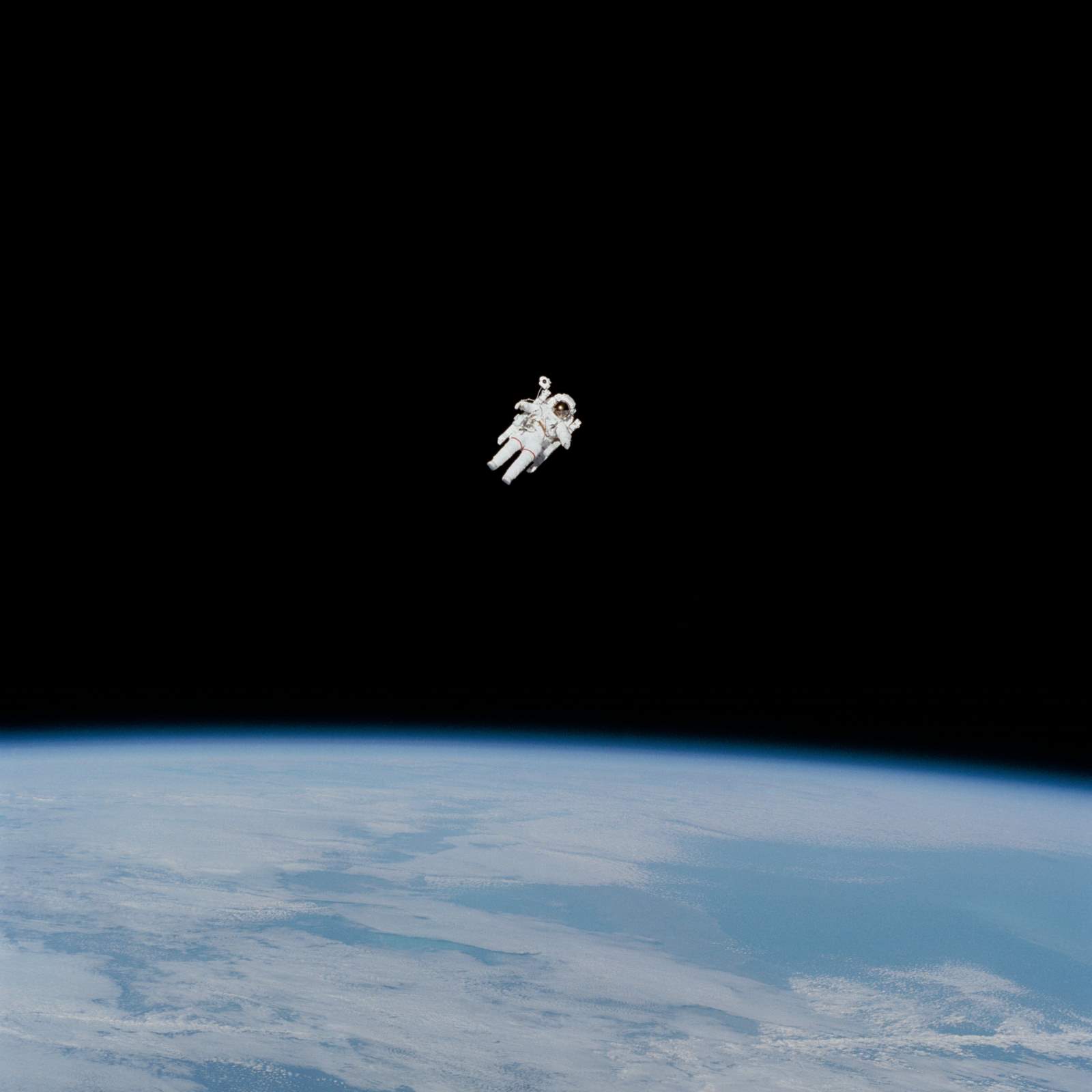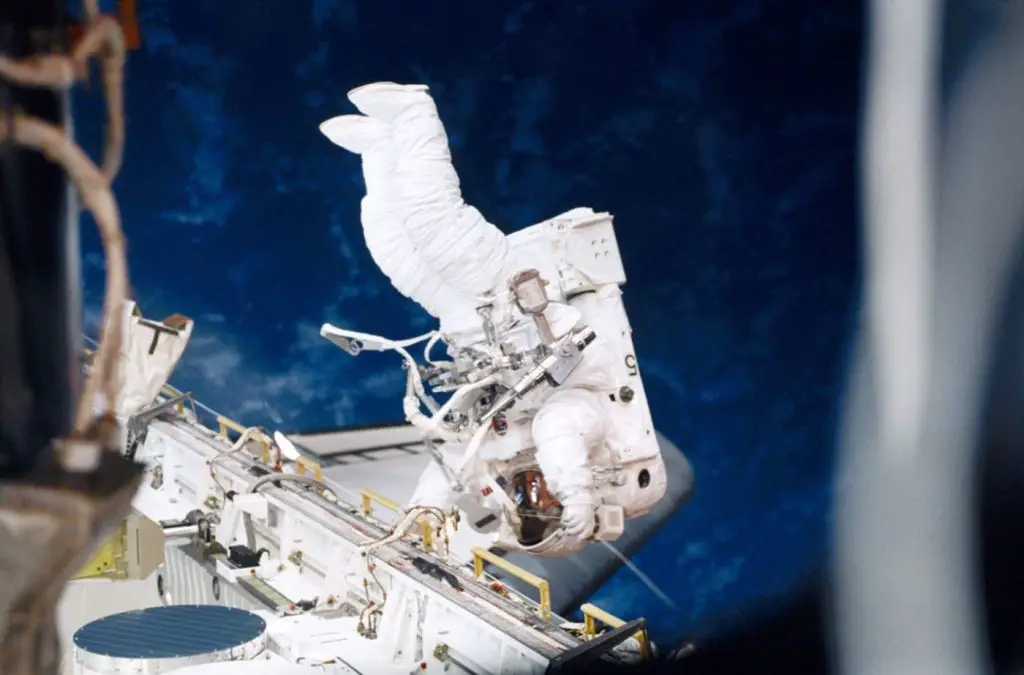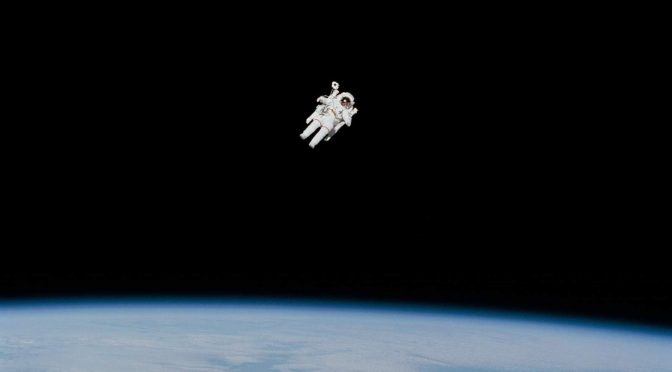On February 7, 1984, during the STS-41-B (the tenth NASA Space Shuttle mission and the fourth flight of the Space Shuttle Challenger), NASA astronaut Bruce McCandless II (June 8, 1937 – December 21, 2017) made the first-ever untethered free flight using the Manned Maneuvering Unit (see notes 1). With a distance of 98 meters (320 feet) from the space shuttle, he also broke the untethered spacewalking record.
Today’s (February 7) story of what happened this day in Science, Technology, Astronomy, and Space Exploration history.
Bruce McCandless brakes the untethered spacewalking record

McCandless became the first astronaut to maneuver about in space untethered, during this first “field” tryout of a nitrogen-propelled, hand-controlled backpack device called the Manned Maneuvering Unit (MMU).
Not long afterward, NASA discontinued such actions and decided to perform only tethered spacewalks for safety reasons. In 1994, NASA unveiled a new backpack called Simplified Aid for EVA Rescue, or Safer, and tested it with an untethered spacewalk, the fourth, and thus far last untethered extra-vehicular activity it has performed. Every astronaut at the International Space Station wears Safer, which is smaller and lighter than the manned maneuvering units, for use during an emergency.

Related: Top 20 Longest Spacewalks in History
In an interview, McCandless II said: “Flying out to a distance of 100 meters from the Shuttle was indeed fascinating and yielded a spectacular viewpoint. Alas, I had intended to yaw around 180 degrees, to face away from the Shuttle, to contemplate the beauty and emptiness of a space devoid of apparent man-made objects, but there was so much conversation over the three radio channels (Mission Control, the Commander, and Bob Stewart) that I forgot to do so.”
“Unexpectedly, I got very cold while maneuvering at a distance from the Shuttle. On considering the problem it became apparent that the life support system was designed to maintain the comfort of a person working at a moderate level of physical exertion – and I was using only my fingertips on the controllers. Briefly shutting off the heat rejection subsystem (sublimator) solved that problem. Post-flight, the Flight Surgeon from Mission Control noted that my heart rate (as displayed on telemetry) was normal and constant throughout the EVA, confirming my feelings of being relaxed and in control at all times.”
Of his famous spacewalk, he wrote in 2015: “My wife [Bernice] was at mission control, and there was quite a bit of apprehension. I wanted to say something similar to Neil [Armstrong] when he landed on the moon, so I said, ‘It may have been a small step for Neil, but it’s a heck of a big leap for me.’ That loosened the tension a bit.”
Breaking the spacewalking record: NASA film JSC-849
Narrated by the Commander and crew, this program contains footage selected by the astronauts, as well as their comments on the mission. Footage includes launch, onboard crew activities, and landing.
In the video above, you can watch astronaut Bruce McCandless, the first “human” Earth-orbiting satellite, venture out 320 feet (98 meters) from the
- Commander: Vance D. Brand
- Pilot: Robert L. Gibson
- Mission Specialists: Bruce McCandless, II, Robert L. Stewart, Ronald E. McNair
- Dates: February 3-11, 1984
- Vehicle: Challenger OV-099
- Payloads: PALAPA B-2/PAM-D, WESTAR-VI/PAM-D, IRT, MLR, ACES, IEF, RME, SPAS-01A, SSIP (one experiment), GAS (five experiments), and Cinema 360 camera
- EVA: (MMU) tested the Manned Maneuvering Unit
- Landing site: Runway 15 at Kennedy Space Center, FL
- Narrated by the Commander and crew, this program contains footage selected by the astronauts, as well as their comments on the mission. Footage includes launch, onboard crew activities, and landing.
Update: Bruce McCandless, II passed away on Dec. 21, 2017, at the age of 80
Here is the press release by NASA:
Former NASA astronaut Bruce McCandless II, a mission specialist on the STS-41B and STS-31 missions, died Dec. 21, 2017, at the age of 80.
McCandless is perhaps best remembered as the subject of a famous NASA photograph flying alongside the space shuttle in the Manned Maneuvering Unit (MMU) – the first astronaut to fly untethered from his spacecraft. His time as an astronaut encompassed much more than that mission, including serving as the mission-control communicator for Neil Armstrong’s and Buzz Aldrin’s moonwalk on the Apollo 11 mission.
“Our thoughts and prayers go out to Bruce’s family,” said Robert Lightfoot, NASA’s acting administrator. “He will always be known for his iconic photo flying the MMU.”
McCandless, a retired U. S. Navy captain, was one of the 19 astronauts selected by NASA in April 1966. He was a member of the astronaut support crew for the Apollo 14 mission and was a backup pilot for the first crewed Skylab mission. He flew as a mission specialist on two space shuttle missions. On STS-41B in 1984, he performed the famous spacewalk and on STS-31 in 1990 he helped deploy the Hubble Space Telescope.
Of his famous spacewalk, he wrote in 2015: “My wife [Bernice] was at mission control, and there was quite a bit of apprehension. I wanted to say something similar to Neil [Armstrong] when he landed on the moon, so I said, ‘It may have been a small step for Neil, but it’s a heck of a big leap for me.’ That loosened the tension a bit.”
Born June 8, 1937, in Boston, McCandless graduated from Woodrow Wilson Senior High School, Long Beach, California. He received a bachelor of science degree from the United States Naval Academy in 1958, a master of science degree in Electrical Engineering from Stanford University in 1965, and a master’s degree in Business Administration from the University of Houston at Clear Lake City in 1987.
He was a co-investigator on the M-509 astronaut maneuvering unit experiment flown in the Skylab Program and collaborated on the development of the MMU. He was responsible for crew inputs to the development of hardware and procedures for the Inertial Upper Stage (IUS), the Hubble Space Telescope, the Solar Maximum Repair Mission, and the Space Station Program. McCandless logged more than 312 hours in space, including four hours of flight time using the MMU.
Among the awards and honors received by McCandless are the Legion of Merit (1988); Department of Defense Distinguished Service Medal (1985); National Defense Service Medal; American Expeditionary Service Medal; NASA Exceptional Service Medal (1974); American Astronautical Society Victor A. Prather Award (1975 & 1985); NASA Space Flight Medal (1984); NASA Exceptional Engineering Achievement Medal (1985); National Aeronautic Association Collier Trophy (1985); Smithsonian Institution National Air and Space Museum Trophy (1985). He was awarded one patent for the design of a tool tethering system that was used during shuttle spacewalks.
Captain McCandless was the son of the late Rear Admiral (USN) and Mrs. Bruce McCandless. Admiral McCandless received the Congressional Medal of Honor for the naval battle of Guadalcanal, December 12-13, 1942. He passed away in 1968. His paternal grandfather, Commodore (later Rear Admiral) Byron McCandless, USN, received the Navy Cross for World War I, and his maternal grandfather, Captain Willis Winter Bradley, USN, was the first recipient of the Congressional Medal of Honor in World War I.
Capt. McCandless is survived by his wife, Ellen Shields McCandless of Conifer, Colorado; his son, Bruce McCandless III of Austin, Texas, and his wife, Patricia; his daughter, Tracy McCandless, of Islamorada, Florida, and two granddaughters, Emma Rose and Carson Clare McCandless of Austin. He is also survived by a brother, Douglas M. McCandless of Washington, D.C.; and two sisters, Sue M. Woodridge of Texas, and Rosemary V. McCandless of Dallas, Texas.
Notes
- The Manned Maneuvering Unit (MMU) is an astronaut propulsion unit that was used by NASA on three Space Shuttle missions in 1984. The MMU allowed the astronauts to perform untethered EVA spacewalks at a distance from the shuttle. The MMU was used in practice to retrieve a pair of faulty communications satellites, Westar VI and Palapa B2. Following the third mission, the unit was retired from use. A smaller successor, the Simplified Aid For EVA Rescue (SAFER), was first flown in 1994 and is intended for emergency use only.
Sources
- Bruce McCandless II on Wikipedia
- Manned Maneuvering Unit on W
ikipedia - “NASA Celebrates 50 Years of Spacewalking” on NASA.gov
- “Astronaut Bruce McCandless II Dies at 80” on NASA.gov
- How Many Elephants are Left in the World in 2025? - August 17, 2025
- Moon Landings: All-Time List [1966-2025] - February 2, 2025
- What Is Max-Q and Why Is It Important During Rocket Launches? - January 16, 2025
